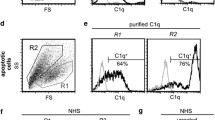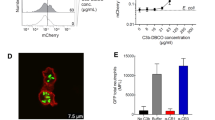Abstract
During the course of a previous investigation, we noticed that the uptake of liposomes by human polymorphonuclear neutrophils (PMNs) was significantly lower in the presence of heat-inactivated serum compared to that in intact whole serum (Scieszka et al., Pharm. Res. 5:352, 1988). This observation suggested the participation of heat-labile complement components in the phagocytic process. In this report we conclude that complement C3bi is the component responsible for opsonization of the liposome surface. Phagocytosis was not supported by C3-deficient serum, and phagocytosis in whole serum was blocked by the antibody to the receptor for C3bi (CR3) but not by the antibody to the receptor for C3b (CR1). We also found that with C5-deflcient serum the level of uptake was minimal but slightly higher than without any serum. When exogenous C5a was added along with C5-deficient serum, uptake levels similar in magnitude to those observed with intact serum were obtained. We conclude that C5a enhances phagocytosis of opsonized liposomes by activating the phagocytic capacity of CR3 on the PMN.
Similar content being viewed by others
REFERENCES
J. F. Scieszka and M. J. Cho. Cellular uptake of a fluid-phase marker by human neutrophils from solutions and liposomes. Pharm. Res. 5:352–358 (1988).
M. J. Cho, J. F. Scieszka, C. T. Cramer, D. P. Thompson, and T. J. Vidmar. Neutrophil-mediated transport of liposomes across the Madin Darby canine kidney epithelial cell monolayer. Pharm. Res. 6:78–84 (1989).
L. Huang. Liposome-cell interactions in vitro. In M. J. Ostro (ed.), Liposomes, Marcel Dekker, New York, 1983, pp. 87–124.
L. B. Margolis. Cell interactions with solid and fluid liposomes in vitro: Lessons for “liposomologists” and cell biologists. In G. Gregoriadis (ed.), Liposomes as Drug Carriers: Recent Trends and Progress, John Wiley & Sons, Chichester, 1988, pp. 75–93.
A. J. Schroit, J. Madsen, and R. Nayar. Liposome-cell interactions: In vitro discrimination of uptake mechanism and in vivo targeting strategies to mononuclear phagocytes. Chem. Phys. Lipids 40:373–393 (1986).
M. C. Finkelstein, S. H. Kuhn, H. Schieren, G. Weissmann, and S. Hoffstein. Selectivity in the uptake of liposomes by human leukocytes: A comparison of monocytes, lymphocytes and polymorphonuclear leukocytes. In B. H. Tom and H. R. Six (eds.), Liposomes and Immunology, Elsevier, New York, 1980, pp. 255–270.
J. A. Swanson, B. D. Yirinec, and S. C. Silverstein. Phorbol esters and horseradish peroxidase stimulate pinocytosis and redirect the flow of pinocytosed fluid in macrophages. J. Cell Biol. 100:851–859 (1985).
A. Böyum. Isolation of mononuclear cells and granulocytes from human blood. Scand. J. Clin. Lab. Invest. 21 (Suppl. 97):77–89 (1968).
F. Szoka and D. Papahadjopoulos. Procedure for preparation of liposomes with large internal aqueous space and high capture by reverse-phase evaporation. Proc. Natl. Acad. Sci. USA 75:4194–4198 (1978).
J. F. Scieszka, P. A. Aeed, D. R. Welch, and M. J. Cho. Neutrophil-mediated transfer of polar substances from liposomes to mammary tumor cells in vitro. Int. J. Pharm. 53:167–173 (1989).
S. L. Newman and L. K. Mikus. Deposition of C3b and iC3b onto particulate activators of the human complement system. J. Exp. Med. 161:1414–1431 (1985).
S. D. Wright and F. M. Griffin. Activation of phagocytic cells' C3 receptors for phagocytosis. J. Leuk. Biol. 38:327–339 (1985).
S. K. Lo, P. A. Detmers, S. M. Levin, and S. D. Wright. Transient adhesion of neutrophils to endothelium. J. Exp. Med. 167:1779–1793 (1989).
D. L. Gordon, S. P. McDonald, J. J. Finly-Jones, and P. J. McDonald. Analysis of C3 degradation patterns on bacterial surfaces after opsonization. Aust. Microbiol. 7:191 (1986) (abstract).
S. D. Wright and B. C. Meyer. Phorbol esters cause sequential activation and deactivation of complement receptors on polymorphonuclear leukocytes. J. Immunol. 136:1759–1764 (1986).
S. D. Wright and S. C. Silverstein. Tumor-promoting phorbol esters stimulate C3b and C3b receptor-mediated phagocytosis in cultured human monocytes. J. Exp. Med. 156:1149–1169 (1982).
K. B. Yancey. Biological properties of C5a: Selected in vitro and in vivo studies. Clin. Exp. Immunol. 71:207–210 (1988).
R. H. Mueller. Differential opsonization—A new approach for the targeting of colloidal carriers. Arch. Pharm. 322:700 (1989).
Author information
Authors and Affiliations
Rights and permissions
About this article
Cite this article
Scieszka, J.F., Maggiora, L.L., Wright, S.D. et al. Role of Complements C3 and C5 in the Phagocytosis of Liposomes by Human Neutrophils. Pharm Res 8, 65–69 (1991). https://doi.org/10.1023/A:1015830306839
Issue Date:
DOI: https://doi.org/10.1023/A:1015830306839




